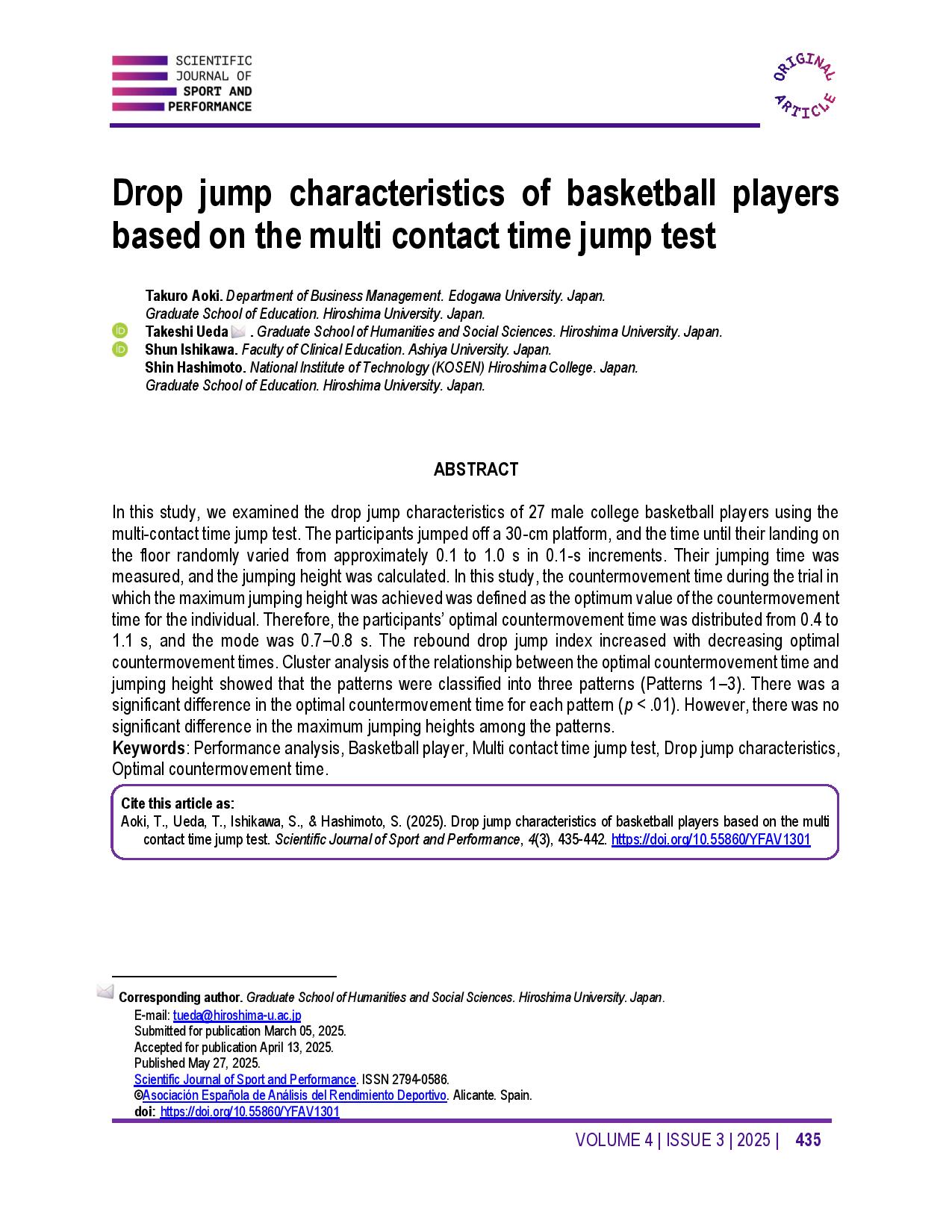Drop jump characteristics of basketball players based on the multi contact time jump test
Main Article Content
Abstract
In this study, we examined the drop jump characteristics of 27 male college basketball players using the multi-contact time jump test. The participants jumped off a 30-cm platform, and the time until their landing on the floor randomly varied from approximately 0.1 to 1.0 s in 0.1-s increments. Their jumping time was measured, and the jumping height was calculated. In this study, the countermovement time during the trial in which the maximum jumping height was achieved was defined as the optimum value of the countermovement time for the individual. Therefore, the participants’ optimal countermovement time was distributed from 0.4 to 1.1 s, and the mode was 0.7–0.8 s. The rebound drop jump index increased with decreasing optimal countermovement times. Cluster analysis of the relationship between the optimal countermovement time and jumping height showed that the patterns were classified into three patterns (Patterns 1–3). There was a significant difference in the optimal countermovement time for each pattern (p < .01). However, there was no significant difference in the maximum jumping heights among the patterns.
Article Details

This work is licensed under a Creative Commons Attribution-NonCommercial-ShareAlike 4.0 International License.
References
Aruga Seiji, Tsumiyama Masaaki, Fujii Masahiro, Ogata Hiroki and Ubukata Hiroki (2012). A Study on the Training Method for Improving Change in Direction Movement: Ability of Rebound Jump in Female Volleyball Players., Tokai J. Sports Med. Sci., 24,7-18.
Aruga Seiji, Tsumiyama Masaaki, Fujii Masahiro, Koyama Takeshi, Ogata Hiroki and Ubukata Ken (2013). A Study on Training Methods for Improving Performance of Change in Direction Movements −The Relationship between the Characteristic of Rebound Jump Ability and the Ability of Change in Direction−, Tokai J. Sports Med. Sci., 25,7-19.
Fujibayashi Nobuaki, Kariyama Yasushi, Kinomura Yoshinori and Zushi Koji (2013). The relationship between common ability to perform the ballistic stretch-shortening cycle movement in unilateral horizontal jump events and performance of various jump events., Japan J. Phys. Educ. Hlth. Sport Sci., 58, 61-76. https://doi.org/10.5432/jjpehss.12009 DOI: https://doi.org/10.5432/jjpehss.12009
Ishikawa Ryousuke (2020). Relationship between jumping ability and track and field events based on MCT-jump test, Hiroshima University Graduation Thesis, 1-48.
Kajitani Ryousuke, Maemura Kimihiko, Fujii Hiroaki, Maeda Kei, Ogata Mitsugi, Kigoshi Kiyonobu (2017). Relationship between the characteristics of recoil motion evaluated by jumping motion and sprinting motion in sprint running. The 16th Annual Meeting of the Japan Association of Athletics Federations.
Kajitani Ryosuke, Maemura Hirohiko, Yamamoto Kohei, Seki Keitaro, Ogata Mitsugi and Kigoshi Kiyonobu (2018). Method for evaluating the characteristics of counter movement in jump exercises. Japan J. Phys, Educ. Hlth. Sport Sci., 63, 139-149. https://doi.org/10.5432/jjpehss.16106 DOI: https://doi.org/10.5432/jjpehss.16106
Kariyama Yasushi, Endo Toshinori, Fujii Hiroaki, Mori Kenichi, Ogata Mitsugi and Zushi Koji (2012) The characteristics of takeoff movement and joint kinetics during the rebound-type jump using single-leg takeoff comparison with the rebound-type jump using double-leg takeoff., Japan J. Phys. Educ. Hlth. Sport Sci. 57: 143-158. https://doi.org/10.5432/jjpehss.11036 DOI: https://doi.org/10.5432/jjpehss.11036
Kariyama Yasushi, Fujii Hiroaki, Mori Kenichi and Zushi Koji (2013). Differences in the characteristics of 3-dimensional joint kinetics between single-leg and double-leg rebound jump. Japan J. Phys. Educ. Hlth. Sport Sci. 58: 91-109. https://doi.org/10.5432/jjpehss.12034 DOI: https://doi.org/10.5432/jjpehss.12034
Kigoshi Kiyonobu (2016). Biomechanics of Jumping Competitions, Journal of Athletics, 14(1), 60-67.
Koyama Takeshi, Rikukawa Akira and Yamada Hiroshi (2012). Different types of jumping abilities during basketball games, Tokai J. Sports Med. Sci.,24,27-31.
Miura K, Yamamoto M, Tamaki H and Zushi K. (2010). Determinants of the abilities to jump higher and shorten the contact time in running 1-legged vertical jump in basketball, J. strength Cond. Res., 24(1), 201-206. https://doi.org/10.1519/JSC.0b013e3181bd4c3e DOI: https://doi.org/10.1519/JSC.0b013e3181bd4c3e
Norman, R. W. and Komi, P. V. (1979). Electromechanical delay in skeletal muscle under normal movement conditions. Acta Physiol. Scand., 106, 241-248. https://doi.org/10.1111/j.1748-1716.1979.tb06394.x DOI: https://doi.org/10.1111/j.1748-1716.1979.tb06394.x
Ogata Mitsugi, Kigoshi Kiyonobu (2020). Development of a new index to evaluate athletes' spring -Aiming at its application to conditioning-.
Takamatsu Kaoru (2017). Overview of Research on Rebound Jump Ability Assessment and Future Issues, Science of Physical Education, 67(4), 254-261.
Tauchi Kenji, Yoon Sungiin, Kuriyama Yoshinari and Takamatsu Kaoru (2002). Characteristics of physical fitness for javelin throwers focusing on the ability to achieve ballistic stretch-shortening cycle movement of the lower limbs., Japan J. Phys. Educ. Hlth. Sport Sci., 47, 569-577. https://doi.org/10.5432/jjpehss.KJ00003390740 DOI: https://doi.org/10.5432/jjpehss.KJ00003390740
Zushi Kouji, Takamatsu Kaoru, Kotoh Takayoshi (1993). The specificity of leg strength and power in several sport athletes., Japan J. Phys. Educ. Hlth. Sport Sci., 38, 265-278. https://doi.org/10.5432/jjpehss.KJ00003391956 DOI: https://doi.org/10.5432/jjpehss.KJ00003391956
Zushi Kouji (2006). Effects of plyometrics on the abilities of the jump, footwork and the chest pass in competitive basketball players., Jpn. J. Phys. Fitness Sports Med., 55, 237-246. https://doi.org/10.7600/jspfsm.55.237 DOI: https://doi.org/10.7600/jspfsm.55.237




